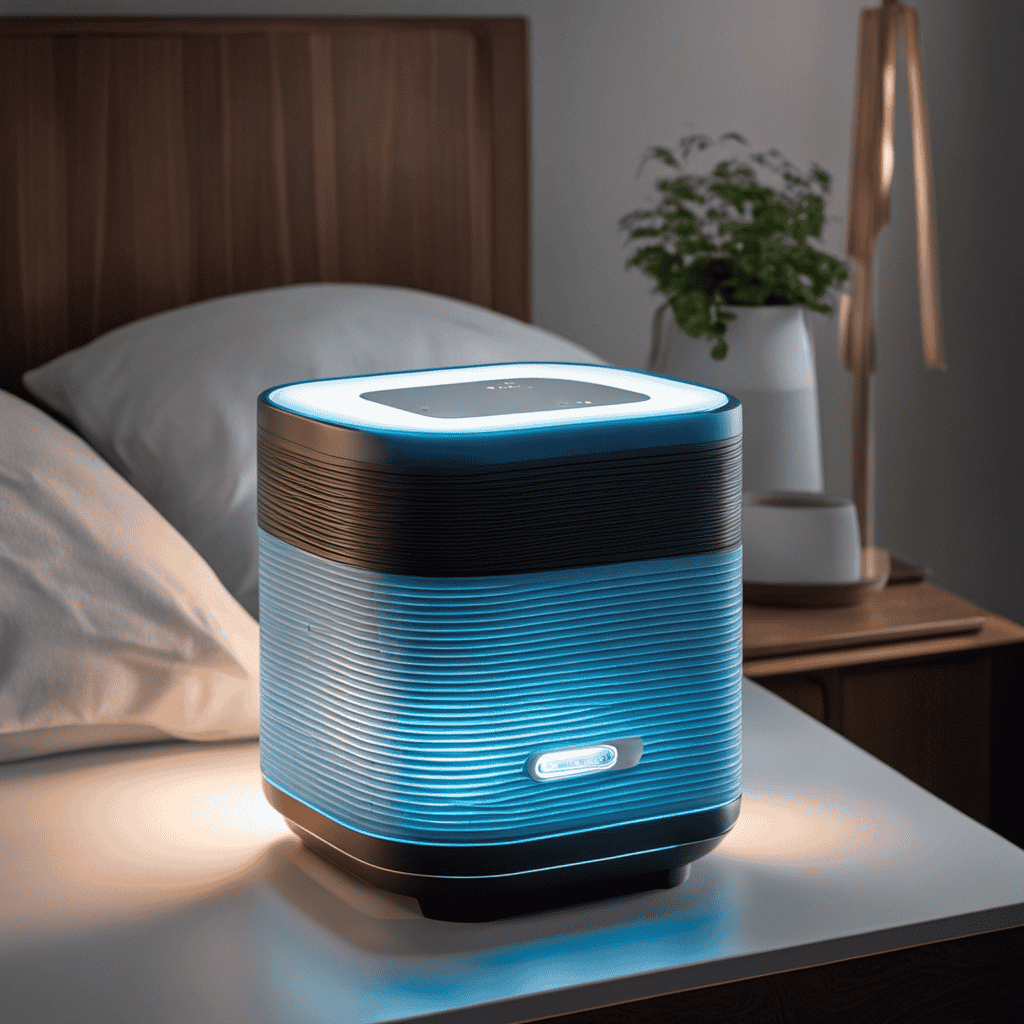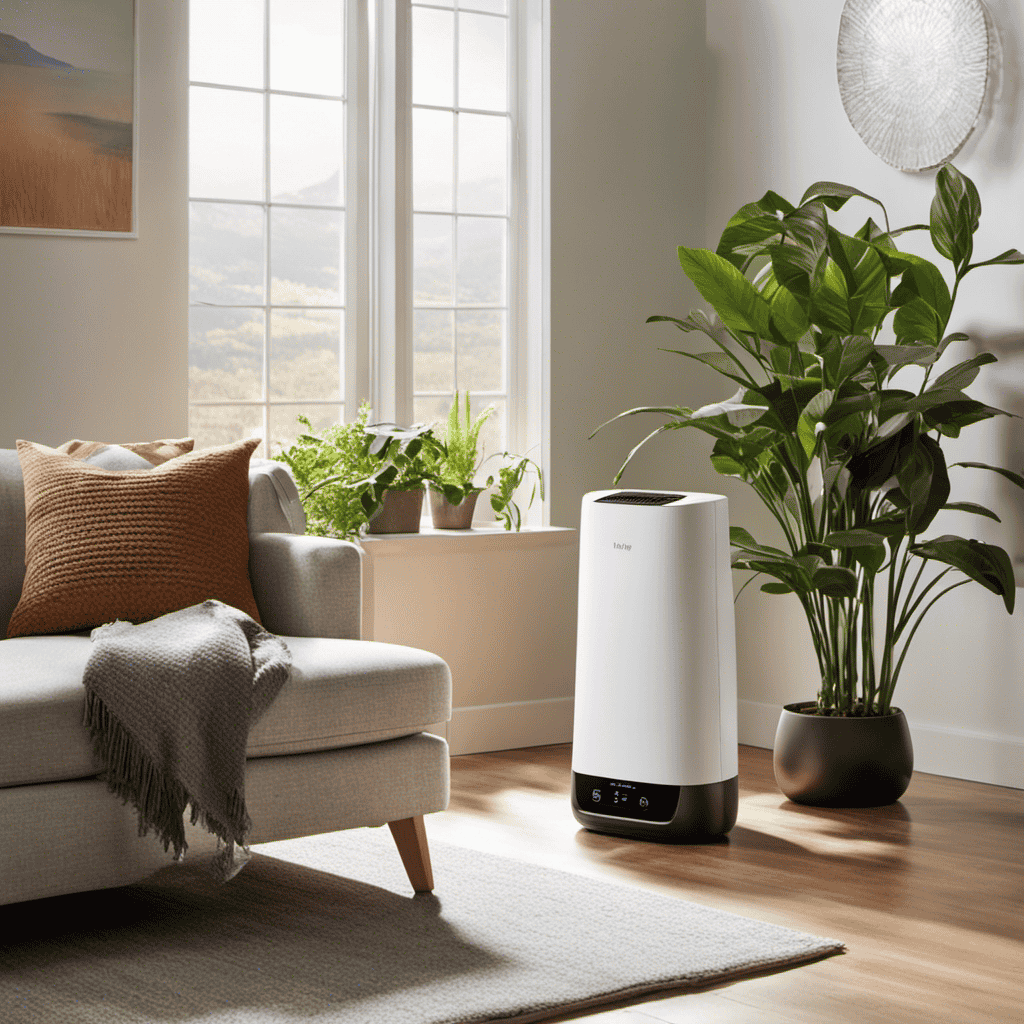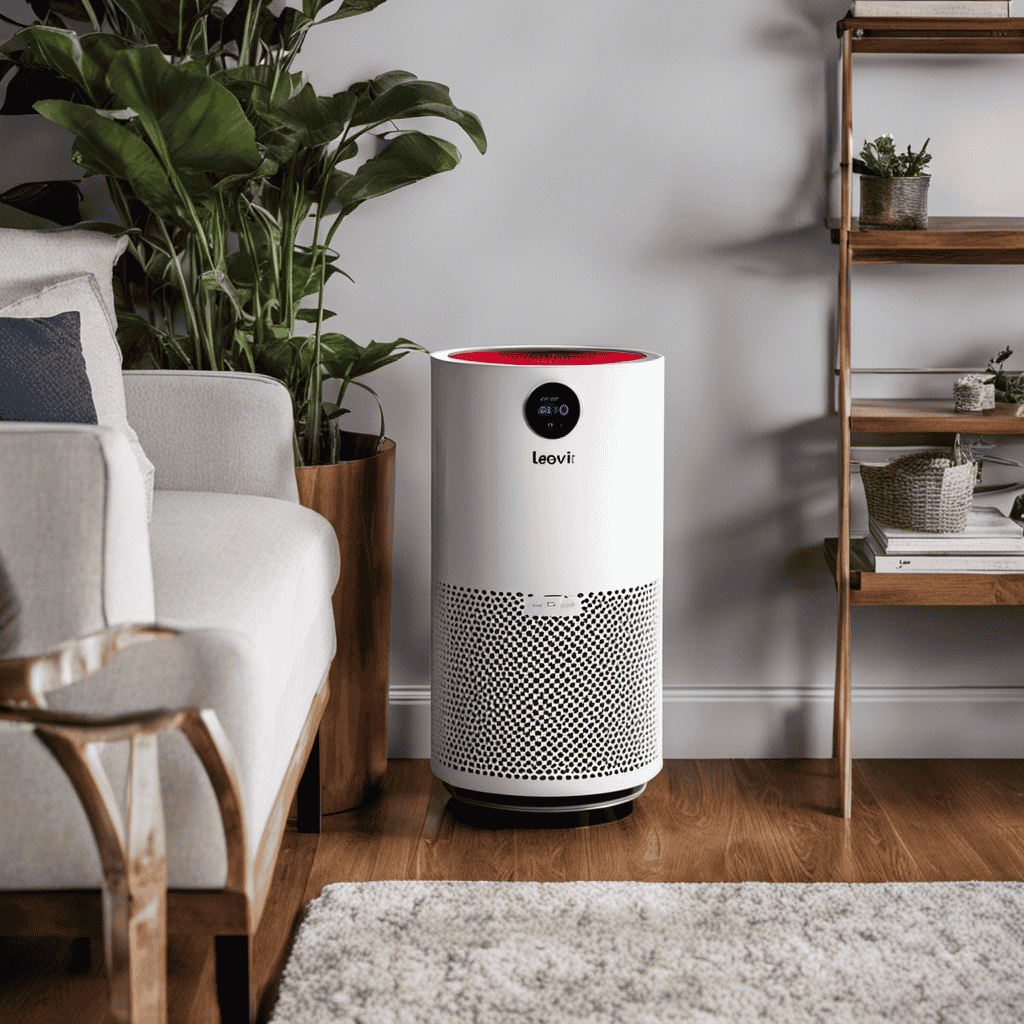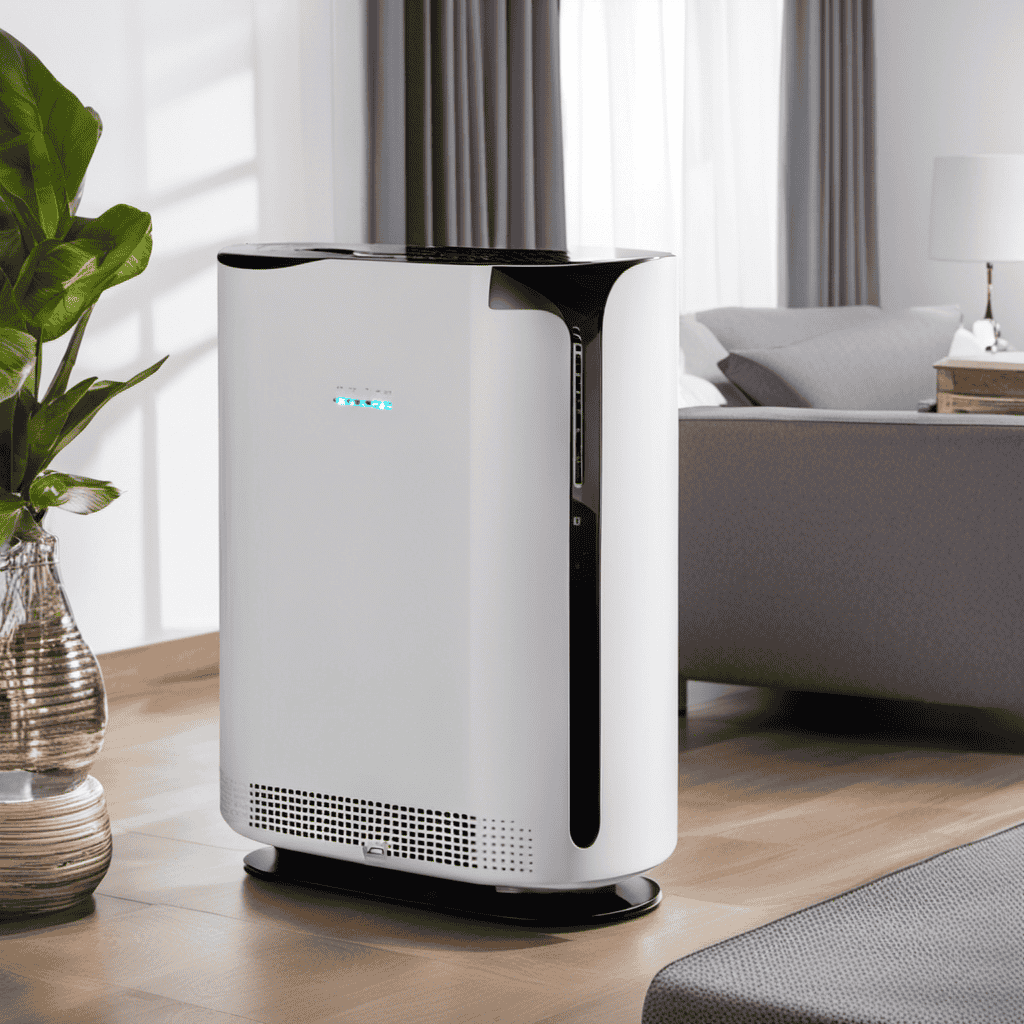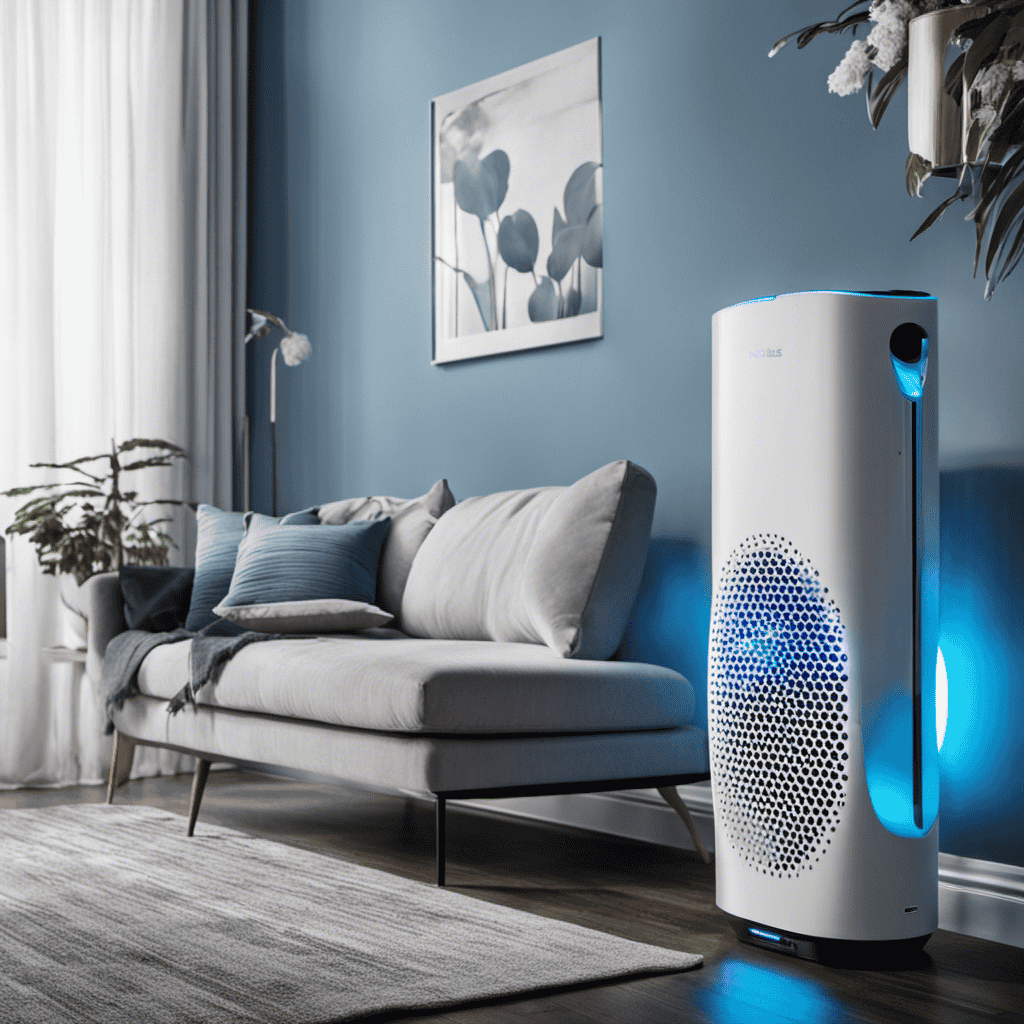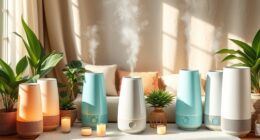Hello there!
Have you ever wondered if it’s safe to be in a room while running an ozone air purifier? Well, I’m here to shed some light on this topic.
In this article, we’ll delve into the potential health risks of ozone air purifiers and explore the importance of understanding ozone levels and exposure limits.
We’ll also discuss precautions you can take to ensure your safety when using an ozone air purifier.
So, let’s get started and debunk some myths along the way!
Key Takeaways
- Ozone air purifiers can cause respiratory issues when inhaled.
- Prolonged exposure to ozone can damage the lungs.
- Choosing air purifiers that do not emit ozone is recommended.
- Proper ventilation is crucial to minimize ozone exposure.
Potential Health Risks of Ozone Air Purifiers
You should be aware of the potential health risks of using ozone air purifiers. While ozone air purifiers are marketed as effective in removing pollutants from the air, they also come with several dangers and side effects.
Ozone, a highly reactive gas, can cause respiratory issues when inhaled. It can irritate the lungs, leading to coughing, wheezing, and shortness of breath. Prolonged exposure to ozone can also damage the lungs, exacerbating existing respiratory conditions such as asthma or chronic obstructive pulmonary disease (COPD).
Additionally, ozone can react with indoor pollutants, such as volatile organic compounds (VOCs), to form harmful byproducts like formaldehyde. These byproducts can further contribute to respiratory problems and potentially lead to long-term health issues.
Therefore, it is crucial to weigh the potential benefits of using ozone air purifiers against the associated health risks before making a decision.
Understanding Ozone Levels and Exposure Limits
Make sure to understand the ozone levels and exposure limits before using the ozone air purifier in a closed space. It is important to be aware of the potential risks associated with ozone exposure and to take necessary precautions.
Here are three key points to consider:
-
Ozone exposure limits: Ozone exposure should be kept within safe limits to prevent adverse health effects. The permissible ozone concentration in indoor air varies depending on guidelines set by regulatory bodies.
-
Ozone concentration monitoring: Regularly monitor the ozone concentration in the room when using an ozone air purifier. This can be done using a reliable ozone monitor to ensure that the levels remain within acceptable limits.
-
Understanding the risks: Prolonged exposure to high levels of ozone can irritate the respiratory system, leading to coughing, shortness of breath, and chest discomfort. It can also exacerbate existing respiratory conditions such as asthma.
Precautions to Take When Using an Ozone Air Purifier
In this discussion, I will be addressing the risks associated with ozone exposure and the safety measures that should be taken indoors.
Ozone exposure can lead to various health issues such as respiratory problems, eye irritation, and lung inflammation. Therefore, it is crucial to implement safety measures such as proper ventilation and limiting exposure to ozone-generating devices.
Understanding the potential risks and taking necessary precautions is essential in maintaining a healthy indoor environment.
Ozone Exposure Risks
Avoid prolonged exposure to ozone when running an ozone air purifier in a room. Ozone, a gas made up of three oxygen atoms, can have harmful effects on your health if inhaled in large quantities. Here are three risks associated with ozone exposure:
-
Respiratory issues: Ozone can irritate the respiratory system, leading to symptoms such as coughing, throat irritation, and shortness of breath. Individuals with pre-existing respiratory conditions like asthma may experience worsened symptoms.
-
Lung damage: Prolonged exposure to ozone can cause inflammation in the lungs and damage to lung tissue. This can lead to reduced lung function and increased susceptibility to respiratory infections.
-
Ineffectiveness of ozone air purifiers: While ozone air purifiers claim to eliminate odors and pollutants, they can actually create more harm than good. Ozone generators produce ozone as a byproduct, which can accumulate in the room and lead to health risks.
To protect your health, it is important to limit your exposure to ozone and choose air purifiers that do not emit ozone.
Safety Measures Indoors
There are several safety measures you can take indoors to reduce your exposure to harmful substances. One important step is to prevent ozone exposure, as ozone can cause respiratory issues and other health problems. Here are some ways to minimize the risks:
| Safety Measure | Description | Benefits |
|---|---|---|
| Ventilation | Ensure proper airflow by opening windows or using fans. | Reduces ozone concentration in the room. |
| Limit Ozone-Producing Activities | Avoid activities that generate ozone, such as using certain appliances or products. | Decreases the overall ozone level indoors. |
| Use Air Purifiers | Choose an air purifier that does not produce ozone. | Filters out pollutants without adding harmful substances. |
| Monitor Ozone Levels | Use air quality monitors to keep track of ozone levels indoors. | Allows you to take necessary actions if the ozone concentration becomes high. |
Health Implications of Ozone
Using an air quality monitor can help you stay informed about the levels of ozone indoors. Ozone exposure can have various effects on our health, and it is crucial to understand the potential risks associated with ozone air purifiers. Here are three important things to consider:
-
Respiratory Issues: High levels of ozone can irritate the respiratory system, leading to symptoms such as coughing, throat irritation, and chest tightness. Prolonged exposure may worsen asthma symptoms or even trigger asthma attacks.
-
Lung Damage: Ozone can cause inflammation in the lungs and damage the lining of the respiratory system. This can result in decreased lung function and compromised respiratory health.
-
Indoor Air Quality: While ozone air purifiers can remove some pollutants, they can also produce ozone as a byproduct. This can lead to increased ozone levels indoors and potentially worsen air quality rather than improving it.
Understanding the health implications of ozone exposure effects is crucial in ensuring ozone air purifier safety. Now, let’s explore the importance of proper ventilation in ozone air purifier usage.
The Importance of Proper Ventilation in Ozone Air Purifier Usage
When it comes to using ozone air purifiers, it is crucial to understand the importance of safe ozone exposure and proper ventilation guidelines.
Ozone, while effective in eliminating odors and pollutants, can be harmful to human health if not used correctly.
Therefore, it is essential to follow ventilation guidelines to ensure that ozone levels remain within safe limits and to minimize any potential risks associated with ozone exposure.
Safe Ozone Exposure
You can safely be in a room while running an ozone air purifier. Ozone exposure limits have been established to ensure the safety of individuals using these devices. Here are some key points to consider:
-
Safe ozone levels: Ozone air purifiers are designed to generate ozone at levels that are within the recommended safety thresholds. These levels are typically low enough to prevent any adverse health effects.
-
Ozone exposure limits: Regulatory bodies have set specific ozone exposure limits to protect individuals from potential harm. These limits vary depending on factors such as duration of exposure and the concentration of ozone in the air.
-
Monitoring and control: Ozone air purifiers often come equipped with sensors and controls to monitor and maintain ozone levels within safe limits. These features help ensure that the ozone concentration remains at a level that is safe for occupants of the room.
Overall, when used properly and within recommended guidelines, ozone air purifiers can effectively improve indoor air quality without posing any significant health risks.
Ventilation Guidelines for Ozone
To ensure proper ventilation, it’s important to consider the recommended guidelines for ozone levels. Ventilation standards play a crucial role in maintaining a healthy indoor environment. Ozone exposure limits should be adhered to in order to prevent any potential health risks.
The American Society of Heating, Refrigerating and Air-Conditioning Engineers (ASHRAE) provides guidelines for indoor air quality, including ozone levels. According to ASHRAE, the recommended ozone limit is 0.05 parts per million (ppm) for continuous exposure over an 8-hour period. It is important to note that prolonged exposure to ozone levels above the recommended limit can cause respiratory issues and other health problems.
Therefore, it is essential to ensure proper ventilation and adhere to the recommended ozone exposure limits to maintain a safe and healthy indoor environment.
Debunking Myths About Ozone Air Purifiers
Don’t believe the myth that you can’t be in a room when running an ozone air purifier. There are common misconceptions about ozone air purifiers, but it’s important to separate fact from fiction. Here are three things you should know about ozone air purifiers:
-
Ozone air purifiers are effective in reducing odors and killing certain bacteria and viruses. They work by releasing ozone, a powerful oxidizing agent, into the air. Ozone molecules attach to pollutants, neutralizing them and improving indoor air quality.
-
Contrary to popular belief, ozone air purifiers are safe to use when proper guidelines are followed. The key is to ensure that the ozone levels remain within the recommended range. This can be achieved by using an ozone air purifier with adjustable settings and by following the manufacturer’s instructions.
-
It’s important to note that ozone air purifiers should not be used continuously in occupied spaces. While ozone can be beneficial in certain situations, prolonged exposure to high levels can be harmful to human health. Therefore, it is recommended to use ozone air purifiers in unoccupied areas or during times when people are not present.
Transitioning into the subsequent section about alternatives to ozone air purifiers for indoor air quality, it’s important to explore other options that can effectively improve the air we breathe.
Alternatives to Ozone Air Purifiers for Indoor Air Quality
In the quest for clean indoor air, there are several natural air purifying methods that can be employed. These alternatives offer a safer and more effective approach to maintaining respiratory health without the need for ozone air purifiers.
One such method is the use of houseplants. Plants have the ability to absorb harmful pollutants and release oxygen, improving air quality in the process. Additionally, opening windows regularly allows for natural ventilation, which helps to circulate fresh air and remove indoor pollutants. Dusting and vacuuming frequently also aids in reducing the presence of allergens and other particles in the air.
To illustrate the effectiveness of these natural air purifying methods, consider the following table:
| Method | Benefits |
|---|---|
| Houseplants | Absorb pollutants and release oxygen |
| Natural ventilation | Circulates fresh air and removes pollutants |
| Regular dusting/vacuuming | Reduces allergens and particles in the air |
Clean air is essential for respiratory health, as it can prevent respiratory issues and allergies. By adopting these natural air purifying methods, we can create a healthier indoor environment for ourselves and our loved ones.
Now, let’s delve into recommendations for safe and effective air purification.
Recommendations for Safe and Effective Air Purification
Consider using a HEPA filter to effectively purify the air in your home. HEPA filters are known for their high efficiency in removing various airborne particles, such as dust, pollen, pet dander, and even some bacteria and viruses. Not only do they provide effective purification, but they are also safe for use in your home.
Here are three reasons why HEPA filters are a great choice for air purification:
-
Effectiveness: HEPA filters have been proven to remove up to 99.97% of particles as small as 0.3 microns. This includes common allergens and pollutants, ensuring cleaner and healthier air for you and your family.
-
Safety: Unlike ozone air purifiers, HEPA filters do not produce ozone, which can be harmful to the respiratory system when inhaled in high concentrations. HEPA filters provide a safe and reliable method of air purification.
-
Versatility: HEPA filters can be used in various settings, such as bedrooms, living rooms, and offices. They are also compatible with most HVAC systems, allowing for whole-house air purification.
Frequently Asked Questions
Can I Leave the Ozone Air Purifier Running Overnight in a Closed Room?
Yes, it’s important to consider the potential risks of leaving an ozone air purifier running overnight in a closed room. Ozone can cause respiratory issues and while it can remove strong odors, it’s best to use it in a well-ventilated space.
Are Ozone Air Purifiers Safe to Use Around Children and Pets?
Ozone air purifiers can be harmful to children and pets. While they are effective in removing odors and pollutants, their drawbacks include potential respiratory issues and irritation. It is best to use alternative air purifiers that are safe for everyone.
How Often Should I Clean or Replace the Filters in an Ozone Air Purifier?
I clean the filters in my ozone air purifier every 3-6 months to ensure optimal performance. Running an ozone air purifier in a bedroom is safe as long as the room is well-ventilated.
Is It Necessary to Have a Dedicated Power Source for an Ozone Air Purifier?
Yes, it is necessary to have a dedicated power source for an ozone air purifier. Ensuring safety is paramount when using ozone technology. A dedicated power source prevents any electrical interference, guaranteeing optimal performance and peace of mind.
Can I Use an Ozone Air Purifier in a Small, Poorly Ventilated Room?
I wouldn’t recommend using an ozone air purifier in a small, poorly ventilated room. Ozone can cause health problems, and the lack of proper ventilation may lead to increased ozone levels.
Conclusion
In conclusion, it’s crucial to approach the use of ozone air purifiers with caution. They can effectively eliminate certain pollutants, but they also pose potential health risks if not used properly. Understanding ozone levels and exposure limits, taking necessary precautions, and ensuring proper ventilation are essential in safeguarding our well-being.
So, before entering a room with a running ozone air purifier, ask yourself: Are you willing to take the risk of breathing in elevated levels of ozone, or would you rather explore safer alternatives for improving indoor air quality? The choice is yours.
